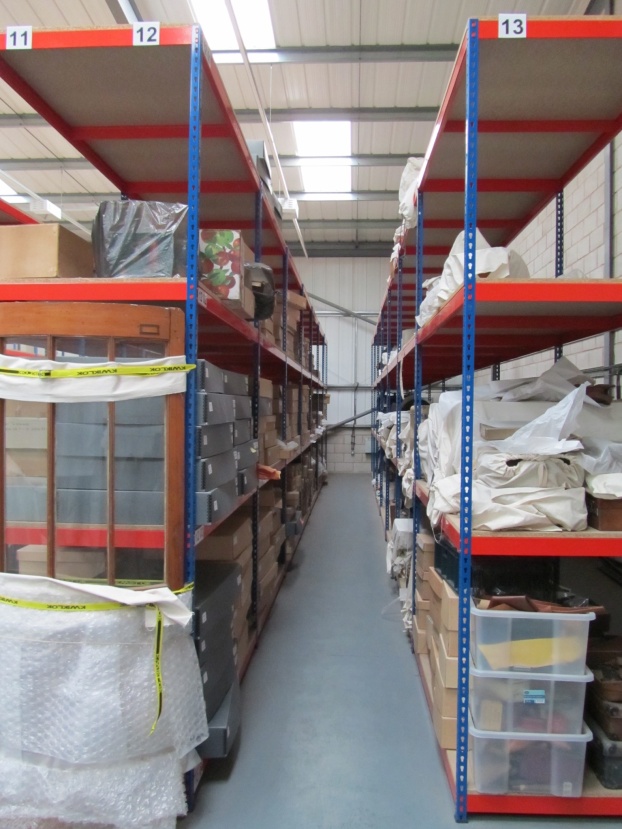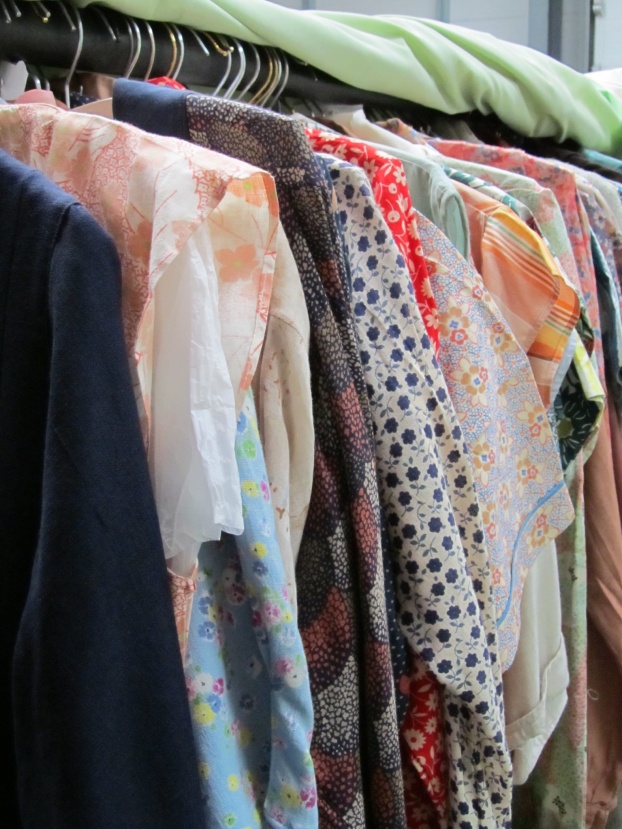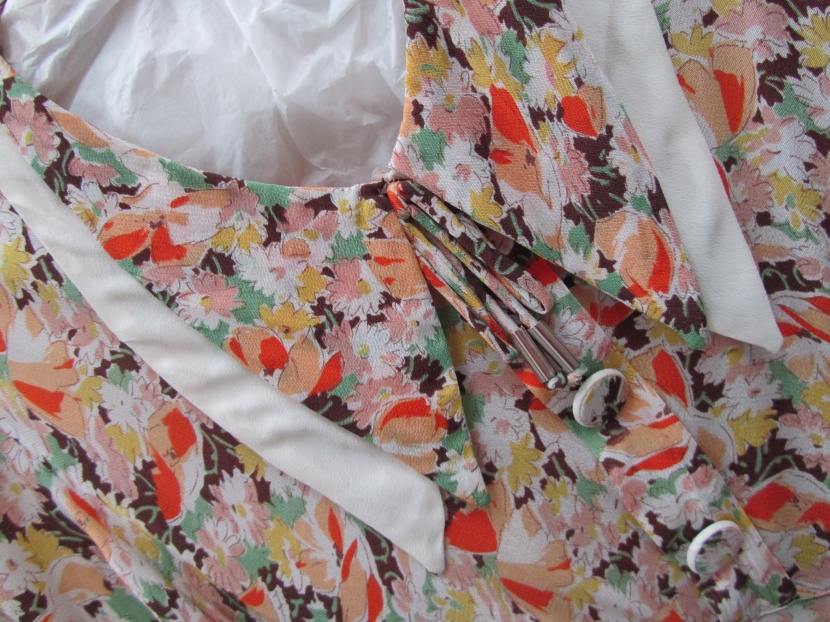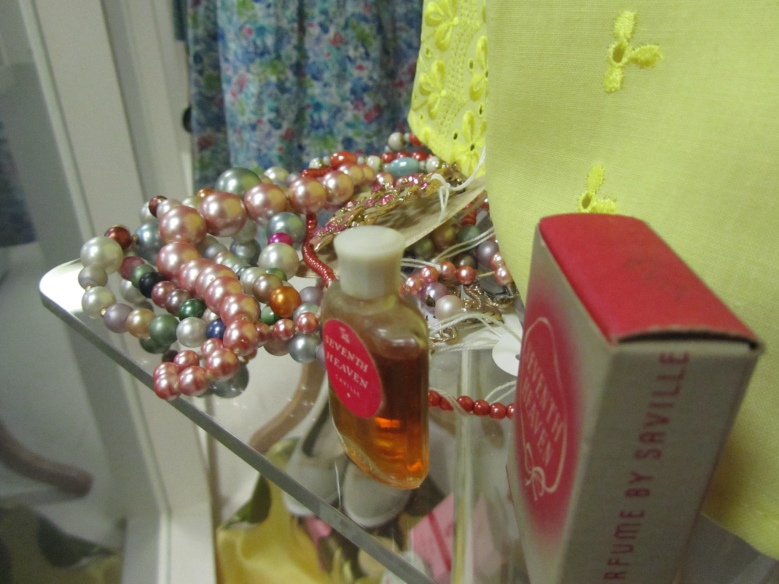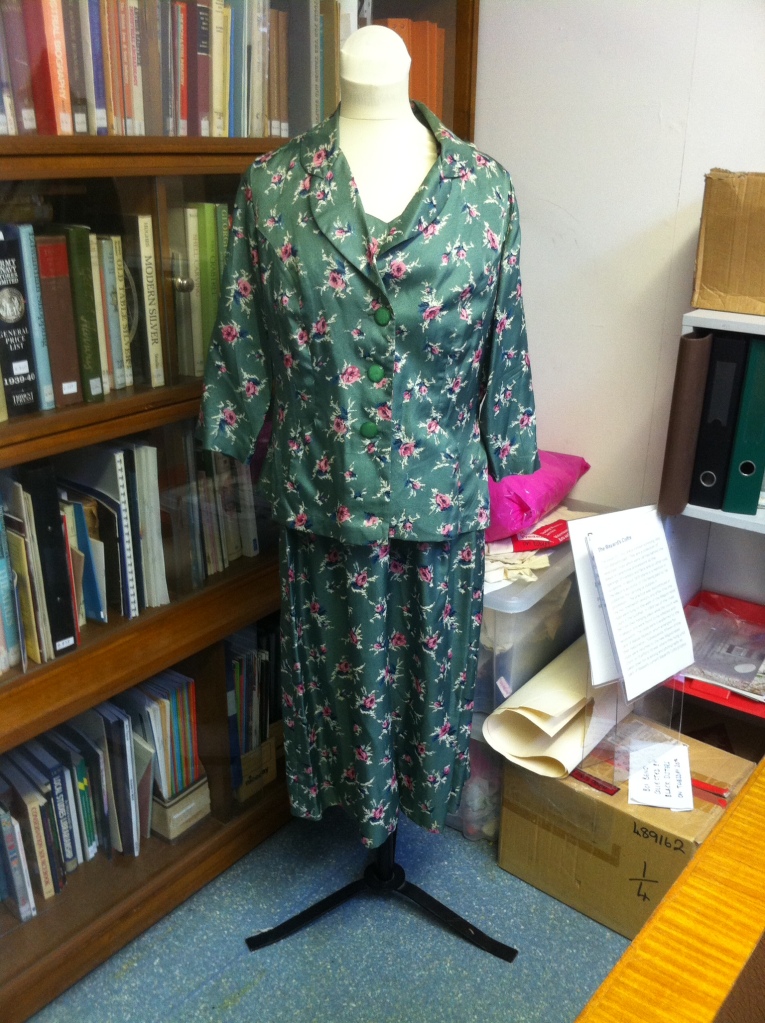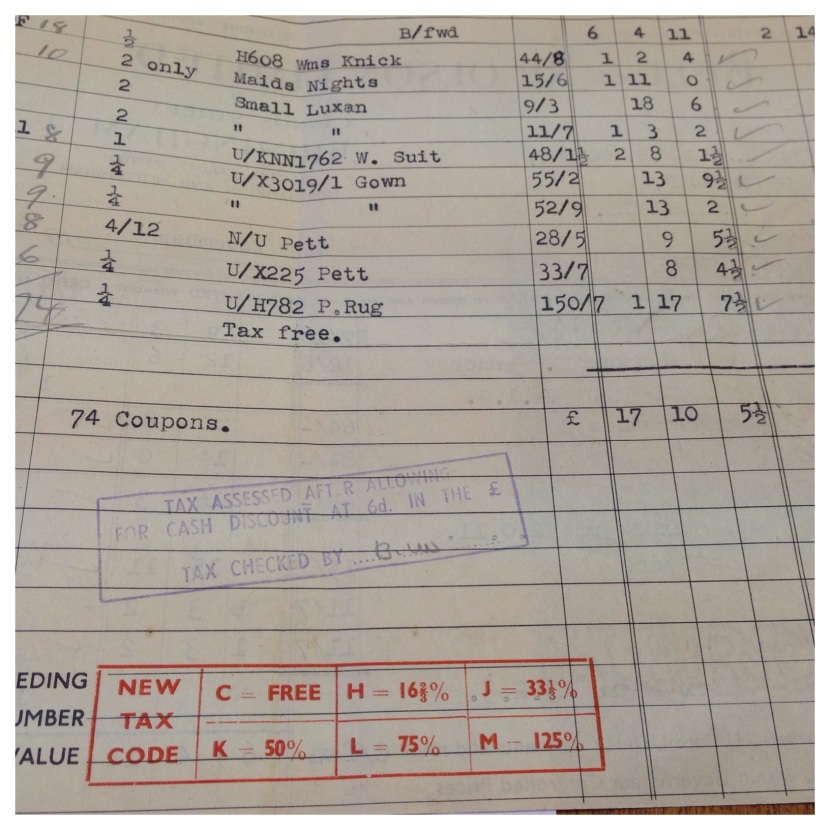Tagged: walsall museum
#InspirationMW and a Fond Farewell
With this being Museums Week, I’ve decided now is a good time to share one of my happiest and most inspiring memories of working with Walsall Museum. Yesterday, people were sharing their museum inspirations on Twitter using the hashtag #inspirationsmw. My museum inspiration started with a visit to Walsall Museum stores back in October 2011.
The museum will close to the public on 31st March 2015. Whilst Walsall Council’s decision to close the museum is saddening, there are reasons to remain positive about the museum’s future. There are plans afoot to move the museum to a new location in 2018 and the Changing Face of Walsall exhibition is being moved to a temporary home at Walsall Leather Museum from 25th July 2015. I’ve also been in discussion with the team regarding pop-up exhibitions. Collections will still be accessible to the public through a range of initiatives – you can find out the full details on the museum’s web page.
As a researcher, I am hopeful that the Hodson Shop Collection (and the rest of the museum’s collection) will continue to be promoted and made available for people to see and study. I’ve seen first hand how people connect with the collection. People can relate to it on a personal level – their mother or grandmother might have worn an apron like that or they had to wear a liberty bodice as a child and can remember the fabric itching on their skin. The Hodson Shop Collection isn’t about spectacle, it is about the everyday things that can often be taken for granted. The things that we don’t expect to find in a museum display but find captivating all the same. Over the two and a half years of this project, I have got to know the collection; without getting too sentimental, it is fair to say that it has found a place in my heart.
It all began back in 2011. I was preparing for my first interview for a PhD studentship and wanted to see the collection up close. I’d never visited a museum store before so I had very little idea of what to expect. I definitely didn’t expect to find myself stood outside a trading estate on the outskirts of Walsall. The building looked like any other anonymous industrial unit, with shutters and a corrugated roof. A forklift truck was buzzing around and there was a constant background clatter of light industry. The surroundings were not in keeping with the treasure trove of twentieth century clothing I had been promised.
Catherine, the museum’s Collections Officer let me in and showed me around. We didn’t know it then but we’d be working together a lot over the coming years. There are plenty of clichés and idioms about judging things by external appearances and I’m going to add another: never judge a museum’s store by it’s exterior. There were shelves stretching from floor to ceiling and aisle after aisle of treasures. The costume collection was stored on a series of calico-covered rails or in boxes stacked down the length of an aisle. Catherine pulled the cover from the Hodson Shop Collection dress rail. The dresses were arranged in age order, starting from the 1920s. I remember being struck by how colourful they were. I was allowed to take out some of the dresses to look at more closely. The first that struck me were the pastel pink and pistachio 1920s dancing dresses with the drop waist and floral corsage. My favourite was a 1930s floral tea dress with a white collar – my first response was ‘there’s something a bit Prada about it’!
There was something magical about opening the boxes and pulling away layers of tissue to reveal the contents. A box of aprons was dazzling, with a riotous mix of prints and gaudy colours. There was the blue and pink wool jersey St Margaret jumper suit, assured in its elegance and (relative) expensiveness to this day. The one thing that has stuck with me in startling clarity was the experience of opening a box of cosmetic items. The smell was overwhelming and instantly familiar – it reminded me of rummaging through my Grandma’s make up bag as a little girl and playing with her frosted pink Avon lipstick. From that point, I knew that I was hooked.
I know that I have been incredibly privileged to get this close to museum items. It is something that I am incredibly grateful to Walsall Museum for. With the closure of the museum, the Hodson Shop Collection will no longer have a display space meaning that the public won’t be able to see the garments. The prospect of the collection being mothballed and kept out of sight is awful. The Hodson Shop Collection has the potential to inspire many, many more people. It needs to be recognised and celebrated as a significant part of not only Walsall’s heritage but of British social and dress history too.
I want to take this opportunity to thank the team at Walsall Museum for their support over the past four years. They have been helpful, knowledgeable and unwavering in their commitment to this project from day one, even when times have been tough.
You can visit Walsall Museum up until Tuesday 31st March. Please show them your support!
Opening hours: Mon-Sat 10am-5pm
Address: Walsall Museum, Lichfield Street, Walsall, West Midlands WS1
Tel: 01922 653116
Exhibition: Austerity to Prosperity
I was honoured and excited when Walsall Museum invited me to take part in planning this exhibition. My brief was to select items from the Hodson Shop Collection that told the story of the transition from wartime austerity to the relative prosperity of the 1950s. The clothing in the collection fits perfectly within this tumultuous period and provides evidence of what Black Country women were wearing during the post-war period. There are the simple yet subduedly elegant utility (CC41) dresses that fade away as the 1950s get into full swing, with full skirts and vivid prints taking over.
My main aim was not to oversimplify the narrative of change; the myth that everyone woke up on 1st January 1950 to find that the drab wartime world had been replaced by a new consumer-driven technicolor dream world. The 1940s may have been a time of austerity but there was still colour, beauty and a booming demand for little luxuries such as lipstick and face powder. Conversely, the 1950s remained austere for many, with food rationing only coming to an end in 1954 (clothing rationing ended in 1949). I reflected this by choosing a few unusual items: a ‘Wartime emergency pack’ of face powder, a surprisingly frilly utility dress, a distinctly dreary wool jersey dress from the 1950s next to a full-skirted confection of a dress from the same time.
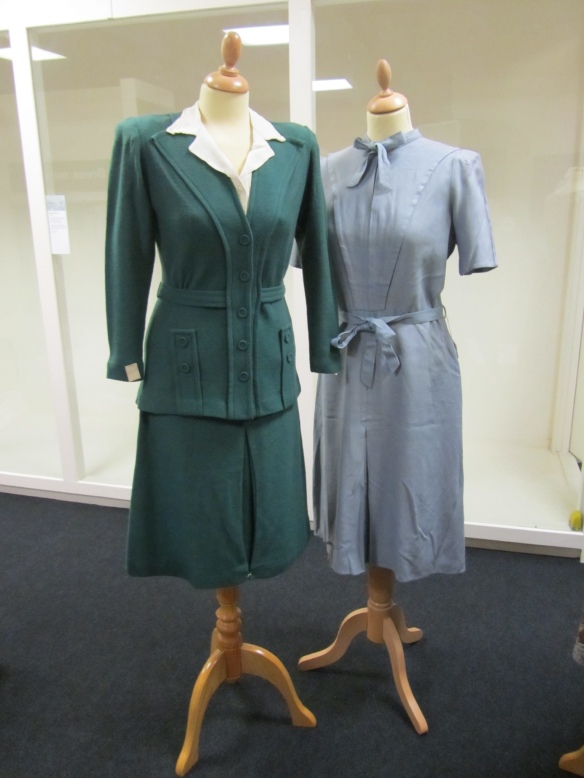
Utility items from the Hodson Shop Collection – creases have been kept in the dress as that is how it was discovered in the Hodson Shop.
Installing the exhibition was great fun and an excellent learning opportunity. I’m really proud of the end result, especially the bit that includes a 1950s twin-tub washing machine!
The clothing accompanies a display of items manufactured or used in the Black Country during the period 1940-1960, again reflecting the aesthetic and ideals of the shift from austerity to prosperity. The exhibition is part of the region-wide Black Country Echoes festival and runs 3 Sept-10 Jan 2015. Admission is free.
Thanks to the team at Walsall Museum for providing me with this opportunity and supporting me along the way!
From Austerity to Prosperity
3 Sept 2014-10 Jan 2015
Community History Gallery, Walsall Museum, Lichfield Street, Walsall.
The Mystery of Morrish & Co.
It all began when I was examining a dress and jacket suit recently accessioned to Walsall Museum’s Community Costume Collection. It was a green crepe ‘sunday best’ style outfit, with a cheery pink rose print. It is from late 1950s or early 1960s (though I could do with doing a bit more research to confirm this). In my more fanciful moments, I can picture Edith or Flora Hodson wearing it whilst bustling off to church or to some family occasion.
Sheila Shreeve found the outfit in a wardrobe at 54 New Road (the property was both the family home and business premises) and there had been some discussion regarding the relationship between the ensemble and the Hodson Shop Collection. The outfit has some very clear signs of wear – soiling around the neckline, evidence of altered hems and repairs and there is even a brooch pinned to the right hand bust. The Hodson Shop Collection is defined as unworn shop stock, with ‘unworn’ being the operative word in this case. Based on the evidence of wear, the outfit was ultimately accessioned into the Community Costume Collection with a note making the relationship to the Hodson Shop clear.
My own study of the garment involved examining the garment inside and out. It was during this process that I noticed the marking under the arms, the repairs in subtly different thread and the clear line of an adjusted hem. I also came across a paper label stitched into the left hand seam of the dress. I can’t find the photo of the label so I will try my best to take one on my next visit to the museum (you can see similar here). From my research notes:
A rectangular paper label is stitched into the left side seam. It is reinforced with a textile mesh on the reverse side. Measures 30mm W x 40mm H. Text is printed in black serif: “MORRISH, LONDON, W1 Ref. C. Style (stamped, red) 194 Prod. (stamped, red) 20035 Mach. (handwritten, pencil) 15 Fin. (stamped, red) 46 Presser Size (stamped, red) 44”
This is where I went wrong. Based on my own experience of clothing labels, I assumed that Morrish were the manufacturers of the outfit. After all, the labels in modern clothing always give the name of the manufacturer, right? This is where the Prownian approach (description, deduction, speculation) to analysing garments proved to be most valuable. It was time to test my hypothesis!
And it turns out that it was very, very wrong. I spent a fascinating afternoon trying to find out who Morrish were. It began, as do many modern adventures in dress history, with a hunt on eBay. I came across several vintage items listed as “Morrish & Co.”, including one rather pretty organza party frock that I came dangerously close to buying (in the name of research, of course). Things got interesting on Etsy where I noticed that listings were far more cautious, referring to ‘order labels’ bearing the name Morrish & Co., as opposed to the stating the company as the manufacturers of the garments. Lots of the garments I came across were listed as appearing to be handmade and there was no real continuity in their style (a sweet party frock one minute, a leopard print-lined leather coat the next). The next phase of my online odyssey took me to an entry on a Vintage Fashion Guild forum. A user called ‘Leonardo da Vintage’ was enquiring about a 50s wiggle dress baring a very similar label. She asked the following questions:
It has a paper hand written label sewn into a seam – what does that indicate? I’ve looked up Morrish & Co, London W1, and the only possibly relevant company made stationary, bags and then shop fittings – so perhaps they made the label, rather than the dress?
Maybe Morrish & Co. weren’t clothing manufacturers after all? Armed with the company name and postcode I decided to search through some trade directories. I hit gold in the Post Office London Directory, 1915 (you can access them via University of Leicester’s wonderful Special Collections Online ‘Historical Directories of England and Wales’) . Listed under ‘PRI’ (which is possibly short for ‘Printers’?) on page 471 I found the following entry :

The listing for Morrish & Co in the 1915 Post Office London Directory. Image via University of Leicester Special Collections Online
I then Googled ‘Morrish & Co 56 Great Titchfield Street’ and the first result was for a company called Morplan. Morplan are suppliers to the fashion industry – they provide labels, ticketing, bags and hangers amongst numerous other bits and pieces essential to clothing retail and manufacture. The ‘About’ page of the website informed me that the ‘Mor’ part of the name was taken from Mr Morrish of Camberwell, SE London who founded the company in 1845. They operated using the names ‘Morrish and Chalfont’, ‘ Morrish & Co.’, ‘Morrish’ and finally ‘Morplan’. They have been operating from Great Titchfield Street, W1 since approx. 1894.
So there’s one mystery pretty much solved: Morrish & Co. made the labels NOT the dresses. I’m not sure how much of this is common knowledge within dress history and vintage circles but it is clearly a red herring that catches many vintage sellers and students like me out. As one mysterious case closes, another one has opened: who made the green ‘Sunday Best’ outfit? I can see this turning into a mammoth trawl through the Hodson Shop Archive. I’ll let you know when I find anything out!
I’m also now beyond intrigued in the history of Morrish & Co. and their links with the fashion industry. Please let me know if you are aware of any research on them. I’ve never really stopped to think about who makes the labels in my clothing, they are one of those small and largely ignored parts of everyday life and dress. There’s a nice project in that somewhere!
Good News!
Walsall Museum has been saved!
As I blogged about previously, the museum was facing the threat of closure as part of a package of cuts by Walsall Council designed to save £19million.
It looks like public support for the museum played a big part in the council’s decision, so massive thanks to those who took part in consultation and/or signed the online petition.
See the Express & Star for more details:
http://www.expressandstar.com/news/2014/02/06/walsall-museum-to-stay-as-people-power-wins/
Whilst researching the history of the Hodson Shop Collection it has become clear that collections are subject to influences far beyond the display case or store room. The closure threat made this strikingly clear.
I’d like to take this opportunity to thank the team at the Walsall Museum for their ongoing support for this project – even during uncertain and troubling times.
The current exhibition at the museum is Gaslight Gothic, which explores the darker side of Walsall’s history. It includes examples of Victorian mourning dress alongside tombstones, taxidermy and other odd and obscure items from the museum’s collection. The exhibition is in the Changing Face of Walsall Gallery on the first floor of the Central Library Building on Lichfield Street, admission is free.
Jenxx
Picture Post: Into the Archive…
Back in November 2013 I posted a selection of colourful and charming images from the Hodson Shop archive. Fast forward to today and I’m still working my way through the archive, though the images I’ll be sharing in this post are far less colourful and, perhaps, not quite so visually striking. Yet that’s not to say that the images are without interest or intrigue…
The archive contains invoices and paperwork as well as the catalogues and other ephemera. I have spent the past few weeks working my way through piles of invoices and delivery notes, searching for any links between the items listed and the objects that I have been analysing within the collection.
The aim of the process has been to build as full a biography as possible for the items. The invoices have the potential to answer a lot of questions. Where did an item come from? Who supplied them? How much did they cost? And when did they arrive? These answers can help to trace the life story of the items before their life in the Hodson Shop and Walsall Museum.
It hasn’t been easy. The invoices rarely give much in the way of descriptive detail – information regarding size or colour is a rarity and brand names tend to only crop up for specific items like corsets, hosiery and toiletries. There have been times when I have cursed the 1920s sales clerks for having such sloppy handwriting and not bothering to tell me the colour of a ‘frock’ ordered in 1923! Yet I have found some fascinating matches.
This non-descript brown paper parcel believed to contain children’s cashmere hose is likely to be the “5914 ¾ Hose” item listed on a N. Corah invoice from 2nd February 1923:
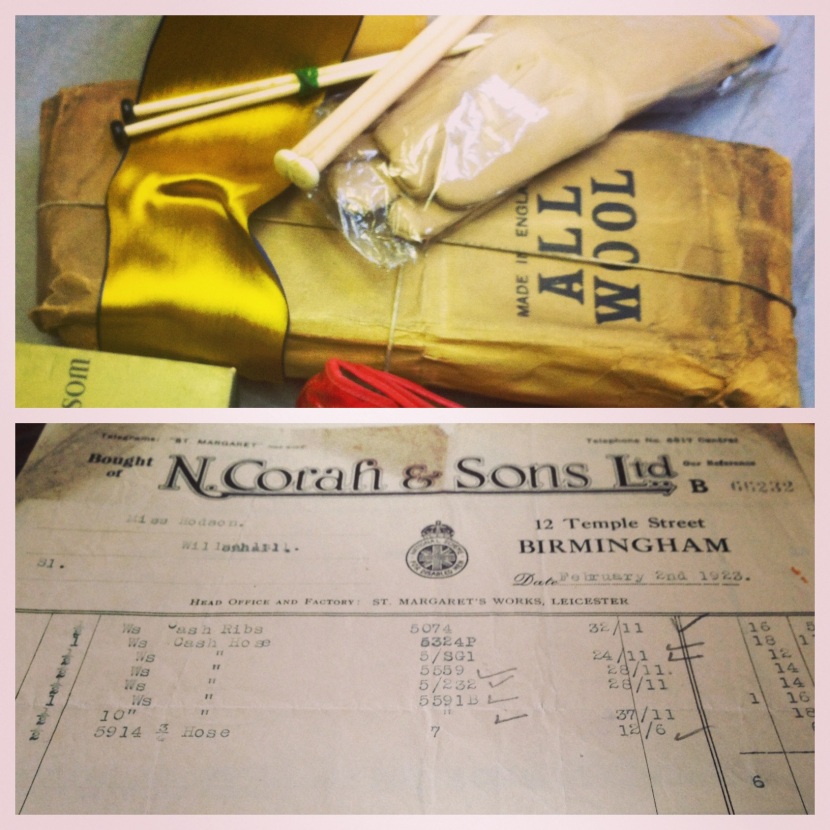
(Top) A parcel containing children’s cashmere hose (Bottom) An invoice from N. Corah & Sons Ltd., 1923 detailing the same hose.
These green ‘mock wing’ feathers? They are listed as ‘Wings’ on this S.C. Larkins & Sons invoice from 18th August 1921:
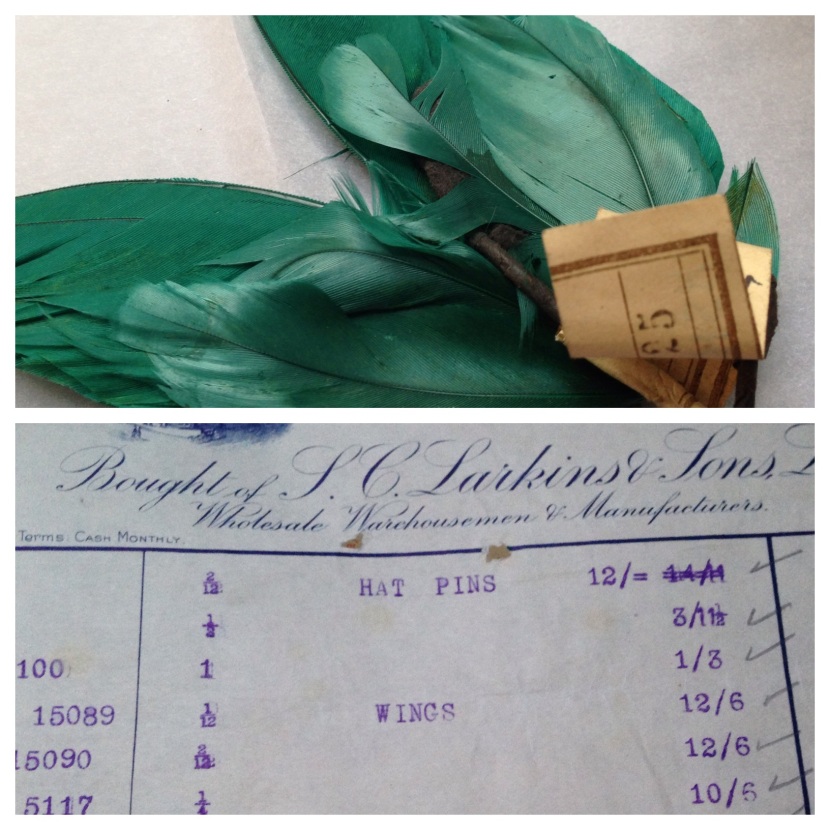
(Top) Jade green mock wings (Bottom) Invoice from S.C. Larkins & Sons Ltd., 1921 listing the same product.
In both of these cases, I’ve been fortunate enough to have item codes to match up. Utility items have been slightly easier to trace, as have some items with the St. Margaret brand due to N. Corah and Sons being both manufacturers and their own wholesaler.
There have been some amusing moments – such as the terribly polite letter from a wholesaler informing Edith Hodson that she wasn’t entitled to the discount she had applied to an order. There’s also the repeated insistence of wholesalers to address Edith and Flora as ‘Sirs’ or ‘Mr Hodson’. Whilst comical to a point, I believe that this error serves to highlight quite how extraordinary Edith and Flora were, operating a business in what was very much a man’s world. They were bold and would often correct such errors. They weren’t afraid to push their luck if it meant saving money:

Letter dated 14th May 1930 from the ‘Counting House’ of N. Corah & Sons Ltd. Note the use of the greeting ‘Dear Sir’.
Something that has struck me is how much stock was coming into the shop. Invoices from some of their major suppliers are often at weekly or two weekly intervals. I need to look into it further but my initial view is that they regularly over-bought, which provides an explanation as to why the Hodson Shop Collection is so large. Another observation is that the sisters tended to only go to the trouble of returning items if they were from local suppliers, such as Walsall-based Ennals & Co. Ltd.. There are far more credit notes from this supplier than others. Maybe travelling to wholesalers further afield was too time consuming and too expensive? Or maybe their goods simply weren’t up to Edith and Flora’s standards?
The invoices themselves are visually interesting. Some feature images of the wholesalers premises, such as S.C. Larkins & Sons Ltd. of Livery Street, Birmingham:
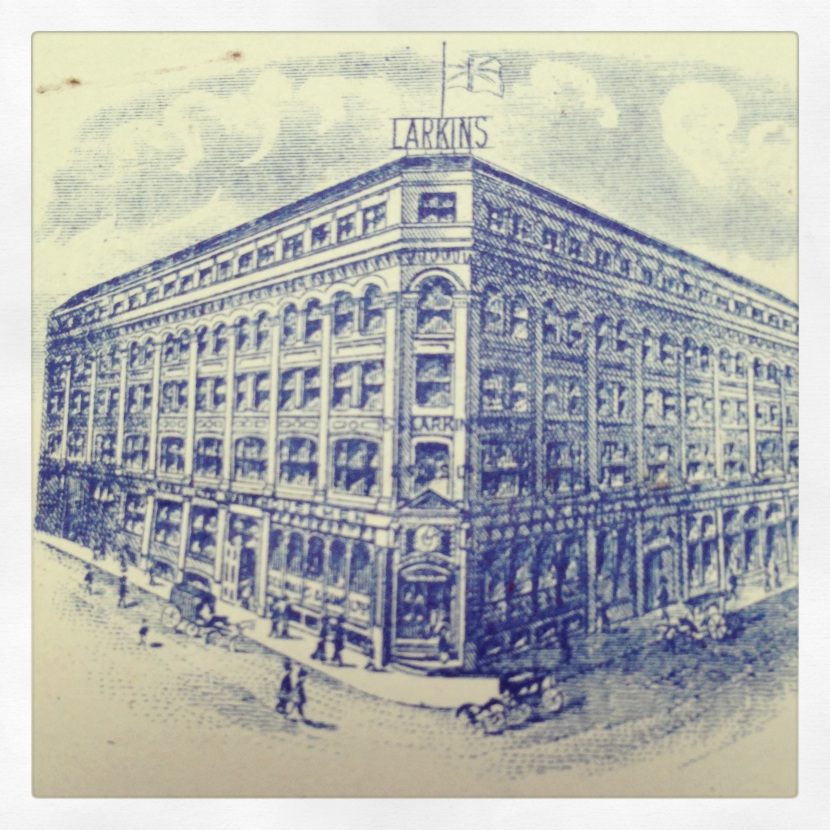
S.C Larkins & Sons wholesalers. Premises on the junction of Livery Street and Barwick Street, Birmingham. Image from 1920 invoice.
There are still hundreds of pieces of paperwork for me to look through and I’m hugely looking forward to being able to cross reference my invoice findings with some of the links I’ve already made between certain items and trade catalogues. It has also been a thrill to see aspects of Edith and Flora Hodson’s personalities show through something as generic and functional as invoices.
Many thanks to Walsall Museum for providing me with access to the archive and for allowing me to photograph the items.
If you wish to explore the Hodson Shop Collection and Archive, please contact Walsall Museum.
Tel: 01922 653116
Email: museum@walsall.gov.uk.
Save Walsall Museum
Over the Christmas break I came across this petition to save Walsall Museum. You can find out more about the closure threat in this post. The petition aims to get 1,000 signatures so it would be great if you could sign and share the link:
http://www.ipetitions.com/petition/save-walsall-museum
This isn’t just about the future of the Hodson Shop Collection, it is about providing a permanent and easily accessible home for the history of Walsall.
Many thanks and a (slightly delayed) Happy New Year to you all!
Jen
Picture Post: Exploring the Hodson Shop Archives
After a busy few weeks (more on which in a future post), it has been a pleasure to finally get back to hands-on archival research. I’ve spent a few days digging through the Hodson Shop archive of trade catalogues, seeking out links to any of the items I have encountered during my object analysis. Plenty have emerged as I’ve worked my way through piles of trade brochures for Birmingham wholesalers such as Wilkinson and Riddell, S.C Larkin and Sons and Bell and Nicholson. The images below are of some of the things that have caught my eye. They aren’t always hugely relevant to my research but they are the things that have raised some intrigue, a smile or a giggle.
I’ve attempted to give as much detail as possible for each image, though I forgot to note the date and wholesaler for this Christmas apron image. I think it is late-1940s/early-1950s Bell and Nicholson, though I’ll double check when I am next at the museum and update the caption accordingly.
I’ve posted before about underwear and how the collection highlights changing attitudes and approaches to undergarments from 1920s-1960s. The 1920s Queen of Scots promotional material is a prime example of this: hygiene and comfort, alongside endorsement from a pious historical figure (c.f. Cardinal Wolsey and his stockings). This is something that I really want to do some more research into (proposed paper title: Piety, Purity and Pants). If you know of any existing work on early-20th century underwear marketing, please let me know!
The 1930s Wilkinson and Riddell catalogue covers are especially stunning – with their Japanese influences and bold artwork. There is something rather charming about their Greyhound logo, especially when placed next to a bonsai tree. The pink and yellow gladioli cover is a personal favourite.
The S.C. Larkin and Sons brochure, New Designs for 1930. Maids’ and Nurses’ Caps, revealed links to Walsall’s famous Sister Dora – the nurse and nun who revolutionised approaches to nursing during the mid-ninteenth century. She created a simple cap for nurses to wear and the brochure shows the design in a number of styles ‘suitable for bobbed hair’.
The final image is of some scribbled notes that I found inside a 1954 Bell and Nicholson catalogue, possibly by Edith or Flora Hodson. There was something eerie about coming across these notes and doodles – as if they were a direct link back to the women and what was going on inside their heads. I’ve seen their handwriting many times before but it has mainly been scrawled numbers or scrappy receipts. These notes seem more personal. And that little sketch of a head? Well, I’m filing that under ‘a bit creepy’.
Many thanks to Walsall Museum for providing me with access to the archive and for allowing me to photograph the items.
If you wish to explore the Hodson Shop Collection and Archive, please contact Walsall Museum.
Tel: 01922 653116
Email: museum@walsall.gov.uk.
Current Exhibition: Red! @ Walsall Museum

From left: printed cotton day dress, c.1951 (Hodson Shop Collection), red grosgrain short evening dress with roses, c.1958.
Sometimes it is the simplest ideas that prove to be the most effective, as evidenced by Walsall Museums latest dress exhibition: Red!
As you might have figured from the title, the exhibition is a celebration the colour red, most specifically the iconic red dress.
All of the dresses have been drawn from Walsall Museum’s massive costume collection and include several items from the Hodson Shop Collection. The dresses are organised in chronological order, starting with this stunning striped muslin day dress from the 1850s (pictured below) and working their way up to this slinky satin wrap dress from the early 1990s (I love the fact that this dress is from Etam). And somewhere in the middle is this grosgrain Wishick and Webber stunner from 1958 (pictured top right).
Hodson Shop dresses include a 1920s cotton day dress with a pointed collar and daisy print, aCC41 (utility) rayon crepe dress with a belt and button details and a 1950s floral print day dress, scattered with stripes and roses (pictured top left). Even though the Hodson dressed are far from the glitziest items on display, they certainly manage to hold their own amongst the frills and flounces.
The visual impact of the colour is undeniable, whether the dress is a glitzy beaded flapper number or a simple utility dress. It is a great starting point for planning outfits for the upcoming party season!
Red! runs until 18th January 2014 at Walsall Museum, Changing Face of Walsall Gallery on the first floor of the Walsall Central Library building. Admission is free! See What’s On Walsall for more details.
Some Sad News: Council Cuts
I received some sad news earlier this week. Walsall Council have announced a package of cuts in spending that will result in the closure of Walsall Museum. Whilst the cuts are currently the subject of public consultation (readers living in Walsall can find details of consultation events here), it is fair to say that things don’t look good. This blog isn’t the place for a detailed explanation of the council’s decisions – for those I point you towards The Express and Star.
It is unlikely that closure will have an adverse effect on my research but it does mean that hardworking, knowledgeable and dedicated staff are now facing the threat of redundancy. It also means that the Hodson Shop Collection (and the museum’s other collections) will retreat even further away from public view. Finally, there’s the fact that the people of Walsall will be losing a place dedicated to their history.
Everything about the situation is sad and my thoughts go out to everyone affected by the announcement. If anything, the news has strengthened my resolve to shout about the Hodson Shop Collection from the rooftops. The collection has so many stories to tell and I’m going to strive to make sure that they are heard.
Jenxxx
